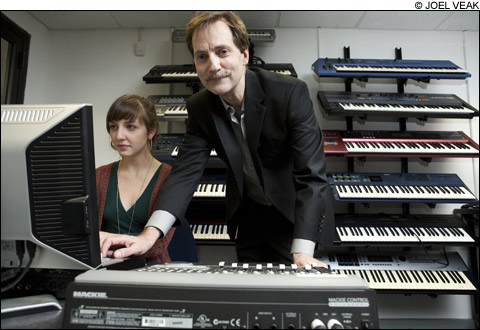
PLATFORMING: Berklee prof Neil Leonard (here with student Julia Easterlin) is bringing his class to Cuba for more than the drums. |
If you were to hear that a group of Berklee students were spending a week in Cuba, you probably wouldn't be too surprised. Surely they would be studying the island's long Afro-Cuban folkloric, popular, and jazz traditions — from Chano Pozo and Beny Moré to Chucho Valdés, Silvio Rodríguez, and Francisco Mela.
But no. The four students of the Berklee Interarts Ensemble going to Cuba on November 27 are, in one way or another, electronic composers. They are studying under the ægis of Neil Leonard, a composer and performer who is also a professor in Berklee's Electronic Production and Design Department. Leonard has studied and performed as a jazz saxophonist, and he's deeply involved in Boston's free-improv scene. But he's also created multimedia installations with, among others, his wife, the artist Maria Magdalena Campos-Pons. Together, Leonard and Campos-Pons run Brookline's GASP gallery and performance space, often the home of experimental music.
So what kind of music does the Interarts Ensemble make? On a trip to Italy in September, collaborating with German musicians, the students went deep into the historic marble cave quarries outside Carrara and recorded ambient sound — as well as the sound of Leonard's saxophone. "It was a space bigger than St. Peter's Cathedral," Leonard tells me as we assemble with his students in a Berklee conference room. The idea, he explains, was to conjure the quality of a specific space through its sounds — they recorded his saxophone more for the resonance and the decay of its pitches than for specific notes. He also shows me, on his laptop, photos of his students on city rooftops recording the sound of the wind from Tuscany's Apuan Alps, the streets below. These ambient sounds become the raw material for compositions and cross-disciplinary collaborations.
As for the current students in Leonard's troupe, they are like a Fantastic Four of mixed backgrounds, all transfers from different schools. The most conventional of the bunch — but not by much — is Julia Easterlin. I suppose you could call this former sociology major a singer-songwriter: she's a wonderfully self-possessed vocalist who happens to perform solo with a combination of acoustic instruments — guitar, percussion — and live electronics, building layers of vocal loops and rhythm before adding her sharp lyrics and folk-type melodies. Enrico de Trezio, from Bari (on the Adriatic, across the boot from Naples), was classically trained from the age of nine before turning to jazz and now, at Berklee, creating shadow-mapping audio-visual installations. Katie Bilinski, a photographer and former journalism major, plays "bass guitar and laptop" and works with John Hull, a former marine-biology major, creating electronic-sound installations. (Bilinski is part of a group show opening at GASP December 9.)
"This is the most eclectic department at Berklee," Leonard tells me, "and these are the most eclectic students in it. They were all going to be doing different things. If you'd asked John before the Italy trip — "
". . . even halfway through the Italy trip," Hull interrupts.